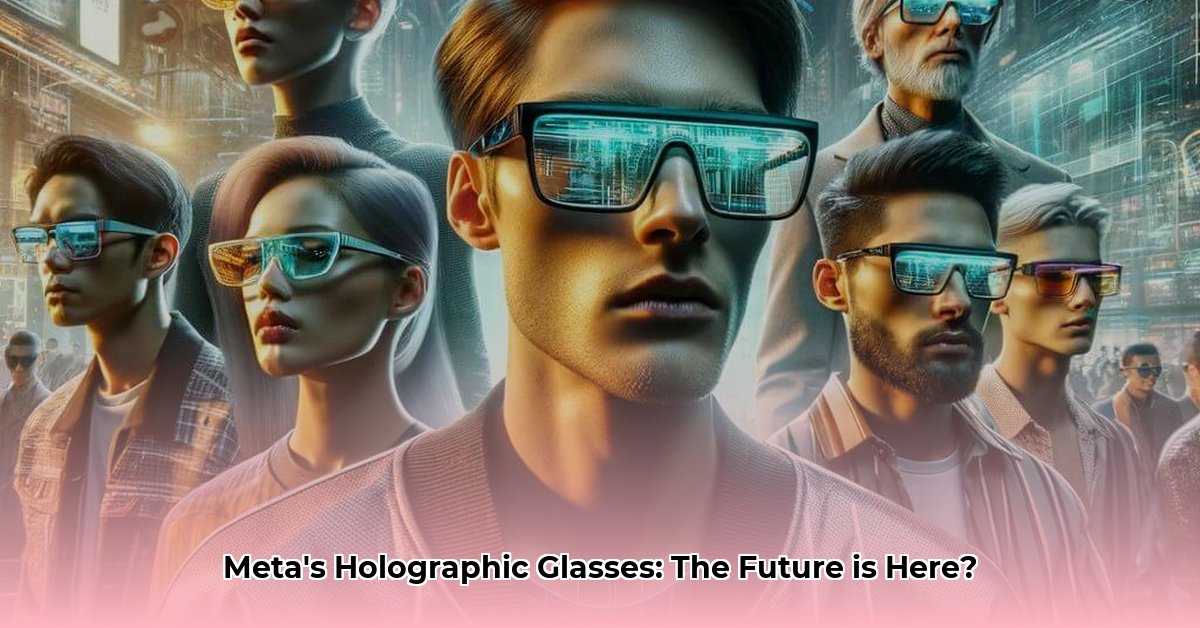Meta’s Project Orion is generating significant buzz in the tech world, promising a future where holographic images seamlessly integrate with our reality. At Meta Connect 2024, Mark Zuckerberg unveiled this ambitious project, showcasing its potential to revolutionize how we interact with the digital world. This article delves into everything we currently know about Orion, from its underlying technology to its potential applications and the challenges it faces.
Decoding the Holographic Magic: How Orion Works
Orion distinguishes itself from existing AR devices by projecting true 3D holograms rather than simple 2D overlays. This “holographic AR” experience is achieved through a combination of innovative technologies:
-
Micro-LED Projectors and Nanostructured Lenses: Miniature projectors, embedded within the glasses’ frame, beam light onto specialized lenses. These lenses, likely constructed from silicon carbide, are etched with microscopic 3D structures at the nanoscale. These structures diffract the projected light, shaping it into the 3D holographic images perceived by the wearer. This eliminates the need for external cameras or cumbersome “passthrough” systems used in other devices.
-
EMG Wristband: The Neural Control Interface: Perhaps the most futuristic aspect of Orion is its potential neural control system. An EMG wristband, worn on the wrist, senses the subtle electrical signals produced by muscle movements. These signals are then translated into commands within the holographic environment, allowing users to manipulate holograms with intuitive hand gestures. This could potentially revolutionize human-computer interaction, moving beyond traditional controllers and touchscreens.
Orion’s Potential: A Glimpse into the Future
Meta’s vision for Orion extends beyond mere entertainment. They envision these glasses eventually replacing smartphones, becoming an integral part of our daily lives. Imagine:
- Holographic Communication: Engaging in realistic 3D video calls, feeling as though you’re in the same room with the other person.
- Interactive 3D Navigation: Holographic maps seamlessly integrated into your surroundings, guiding you through unfamiliar streets with unprecedented clarity.
- Immersive Gaming and Entertainment: Transforming your living room into any imaginable environment, blurring the lines between the physical and digital worlds.
- Revolutionizing Healthcare and Education: From interactive anatomical models for medical professionals to immersive historical recreations for students, the possibilities are vast.
The Challenges Ahead: Roadblocks to Reality
While the potential of Orion is immense, significant challenges remain:
-
Technical Hurdles:
- Battery Life: Powering the holographic projections and sensors will likely require substantial energy, posing a challenge for battery life.
- Field of View: A limited field of view can detract from the immersive experience. While the prototype reportedly has a 70-degree field of view, some suggest this might decrease to 50 degrees for the consumer version.
- Resolution: Achieving crisp, detailed holograms requires high resolution. Orion is currently targeting 13 pixels per degree, aiming to double that to 26 in the future.
- Miniaturization and Wearability: Packing all the necessary technology into a comfortable, wearable form factor is a complex engineering challenge.
-
Ethical and Societal Considerations:
- Privacy: Constantly scanning surroundings raises privacy concerns regarding data collection and access.
- Social Acceptance: Wearing AR glasses in public might face social resistance.
- Misinformation and Manipulation: The potential for misuse of holographic representations needs careful consideration.
Orion vs. the Competition: A Comparative Look
How does Orion compare to existing AR/VR devices?
| Feature | Apple Vision Pro | Meta Orion (Prototype) | Microsoft HoloLens 2 |
|---|---|---|---|
| Display Type | Micro-OLED | Holographic | Holographic |
| Resolution | 4K per eye | Targeting 26 PPD (Projected) | 2K per eye |
| Control Method | Hand/Eye Tracking | EMG Wristband, Hand Tracking | Hand/Eye/Voice |
| Field of View | ~100° | 50-70° (Projected) | 52° |
| Processing | Onboard | External Unit | Onboard |
| Availability | Available | In Development | Available |
| Approximate Price | $3,499 | To Be Determined | $3,500 |
Orion’s holographic display and unique neural control system set it apart. However, it’s crucial to remember that Orion is still in its early stages, while the Vision Pro and HoloLens 2 are commercially available.
When Will Orion Arrive? Deciphering the Timeline
The million-dollar question remains: when will Orion be available to the public? Meta has not announced a release date or price. Initial rumors suggested a 2024 release, but challenges related to manufacturing costs and technical development have likely pushed back the timeline. The demonstration at Meta Connect 2024 focused on the technology’s potential and developer access rather than a consumer launch.
The Future of Holographic AR: A World Transformed?
Meta’s Orion project offers a tantalizing glimpse into the future of augmented reality. While challenges remain, the potential for holographic AR to reshape our interactions with technology and the world around us is undeniable. As research and development continue, we can expect further refinements and breakthroughs that may bring Meta’s vision of a holographic future closer to reality. Stay tuned for updates as Orion’s journey unfolds.







